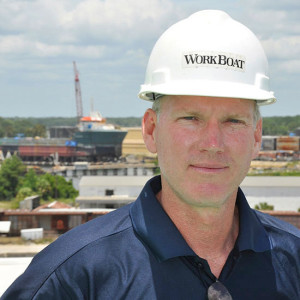There’s been a lot of coverage in the last year or so about liquefied natural gas (LNG) and whether it will take off in the U.S. workboat industry.
In the U.S., Harvey Gulf International Marine is building six dual-fuel, 302' PSVs at Gulf Coast Shipyard Group. The first three STX SV310DF OSVs have been chartered by Shell, and the first PSV was launched in January.
Many are bullish on LNG. A big reason is fuel cost. Depending on usage, Harvey Gulf estimates that LNG could potentially lower vessel operating expenses by as much as $2.4 million per vessel per year. This, the company says, will more than cover the 20% price premium to build LNG vessels versus similar diesel-powered OSVs. LNG-fueled vessels will also be an environmental win. When running in gas mode, the environmental impact is minimized.
At the WorkBoat OSV Design & Technology Regional Summit held this month in Houston, John Dane, president and CEO of Gulf Coast Shipyard Group, said that worldwide, DNV forecasts call for “50% of newbuild OSVs to burn LNG by 2020, with 10% of the world’s fleet dual fueled by 2016.”
But “fuel cost” is also a negative. While the actual cost of LNG fuel is not the issue, outfitting a vessel for LNG-diesel operation is. Essentially, redundant systems with tankage and piping are required, which drives prices higher. Also, bunkering a cryogenic liquid for storage at -260°F requires careful design and planning.
Then there is the loss of cargo capacity below deck. It’s been said that a 300' dual-fuel vessel has the below-deck capacity of a 250' OSV due to the extra storage requirements for LNG. A third argument against LNG and dual-fueled vessels is the lack of bunkering facilities, which is the classic chicken-egg dilemma. Investors want to see the vessels first before investing in LNG bunkering facilities.
At the WorkBoat summit, analyst G. Allen Brooks of PPHB pointed out that there are very few LNG-powered vessels out there. “And even if we start building a bunch now, a lot of the vessels that are under construction now are already committed to what kind of power system they’re going to have. So you’re really talking about the evolution of the LNG carving out over time a larger and larger portion of the fleet. The pace of that will probably be driven by whatever pressures come from the customers, the oil companies, because of emissions concerns or some kind of other environmental issues or regulations.”
Guido Perla, chairman of Guido Perla & Associates, Seattle, also is not sold on LNG. He said the main issue is cost. “We are going to pay dearly in any direction we go, LNG or diesel. There are not good solutions for the future as long as we stay with oil-based, non-renewable products,” Perla said at the summit.
GPA has its LNG PowerPack modular design that deals with the inefficient way of storing LNG and its supporting equipment, but the bottom line, said Perla, is that LNG is not more efficient than diesel.
“LNG is like the pretty girl in high school. Everyone talks about her, but there is not much essence behind her and it costs a lot to take her out to dinner.”
Even so, it is still too early to predict what will happen with LNG here in the U.S.



